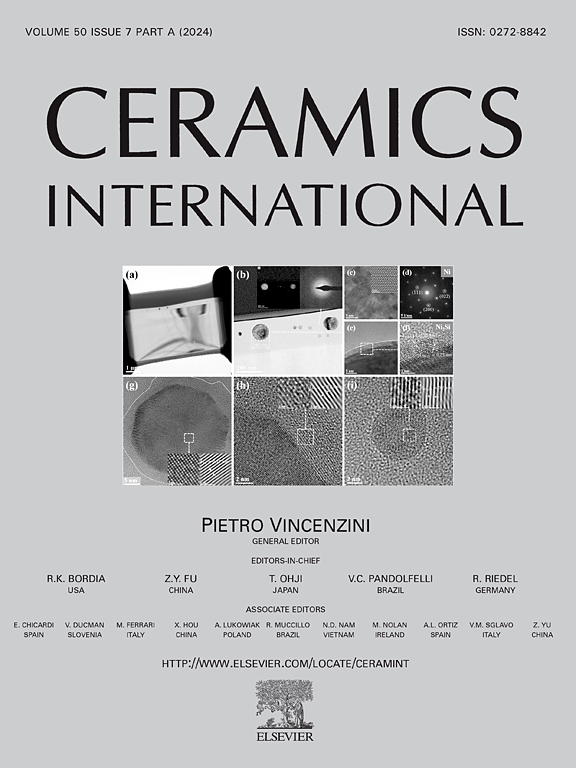Effect of Zn substitution on the structural, magnetic and microwave absorption properties for Z-type Sr3Mg2-xZnxFe24O41 hexaferrites
IF 5.6
2区 材料科学
Q1 MATERIALS SCIENCE, CERAMICS
引用次数: 0
Abstract
A series of polycrystalline Zn-substituted Sr3Mg2-xZnxFe24O41 (x = 0, 0.5, 1.0, 1.5, 2.0) Z-type hexaferrites were fabricated using the sol-gel method. The crystal phase, microstructure, magnetic properties, and microwave absorption performances of the obtained materials were investigated. The magnetic and microwave absorption performance can be effectively modulated by adjusting the amount of Zn doping. The maximum saturation magnetization is 53.6 emu/g for sample x = 1.0, while coercivity gradually decreases with an increase in the Zn-doping concentration from x = 0.0 to 2.0. When the Zn concentration is x = 1.0, the minimum reflection loss reaches −74.1 dB at 7.84 GHz with an absorber thickness of 4.36 mm, and its effective absorption bandwidth (EAB) below −10 dB spans 5.6 GHz (4.24–9.84 GHz). Further increasing the Zn-doping concentration to x = 1.5, the EAB widens to 6.72 GHz (3.68–10.4 GHz) at a thickness of 3.9 mm, covering the entire C band and part of the X band. The excellent microwave absorption properties of Zn-doped Sr3Mg2Fe24O41 (Mg2Z) hexaferrites are attributed to the effective complementarity between impedance matching and attenuation characteristics, resulting from the multiple reflection and scattering, interfacial polarization, dipole polarization, natural resonance, exchange resonance, and eddy current loss. These findings suggest that Zn-doped Mg2Z hexaferrites can be a desirable candidate for developing high-performance microwave absorbers with strong absorption and wide bandwidth requirements.
Zn取代对z型Sr3Mg2-xZnxFe24O41六铁体结构、磁性和微波吸收性能的影响
采用溶胶-凝胶法制备了一系列多晶zn取代Sr3Mg2-xZnxFe24O41 (x = 0,0.5, 1.0, 1.5, 2.0) z型六铁体。研究了所得材料的晶相、显微结构、磁性能和微波吸收性能。通过调整锌掺杂量,可以有效地调节磁性和微波吸收性能。x = 1.0时,样品的最大饱和磁化强度为53.6 emu/g,从x = 0.0到2.0,矫顽力随掺杂锌浓度的增加而逐渐降低。当Zn浓度为x = 1.0时,在7.84 GHz处的最小反射损耗达到- 74.1 dB,吸波器厚度为4.36 mm,其有效吸收带宽(EAB)在- 10 dB以下,宽度为5.6 GHz (4.24 ~ 9.84 GHz)。当zn掺杂浓度进一步增加到x = 1.5时,EAB在厚度为3.9 mm处变宽至6.72 GHz (3.68-10.4 GHz),覆盖了整个C波段和部分x波段。掺锌的Sr3Mg2Fe24O41 (Mg2Z)六铁氧体具有优异的微波吸收性能,是由于多次反射散射、界面极化、偶极极化、自然共振、交换共振、涡流损耗等导致的阻抗匹配和衰减特性的有效互补。这些发现表明,掺杂锌的Mg2Z六铁氧体可以成为开发具有强吸收和宽带宽要求的高性能微波吸收剂的理想候选者。
本文章由计算机程序翻译,如有差异,请以英文原文为准。
求助全文
约1分钟内获得全文
求助全文
来源期刊

Ceramics International
工程技术-材料科学:硅酸盐
CiteScore
9.40
自引率
15.40%
发文量
4558
审稿时长
25 days
期刊介绍:
Ceramics International covers the science of advanced ceramic materials. The journal encourages contributions that demonstrate how an understanding of the basic chemical and physical phenomena may direct materials design and stimulate ideas for new or improved processing techniques, in order to obtain materials with desired structural features and properties.
Ceramics International covers oxide and non-oxide ceramics, functional glasses, glass ceramics, amorphous inorganic non-metallic materials (and their combinations with metal and organic materials), in the form of particulates, dense or porous bodies, thin/thick films and laminated, graded and composite structures. Process related topics such as ceramic-ceramic joints or joining ceramics with dissimilar materials, as well as surface finishing and conditioning are also covered. Besides traditional processing techniques, manufacturing routes of interest include innovative procedures benefiting from externally applied stresses, electromagnetic fields and energetic beams, as well as top-down and self-assembly nanotechnology approaches. In addition, the journal welcomes submissions on bio-inspired and bio-enabled materials designs, experimentally validated multi scale modelling and simulation for materials design, and the use of the most advanced chemical and physical characterization techniques of structure, properties and behaviour.
Technologically relevant low-dimensional systems are a particular focus of Ceramics International. These include 0, 1 and 2-D nanomaterials (also covering CNTs, graphene and related materials, and diamond-like carbons), their nanocomposites, as well as nano-hybrids and hierarchical multifunctional nanostructures that might integrate molecular, biological and electronic components.
 求助内容:
求助内容: 应助结果提醒方式:
应助结果提醒方式:


